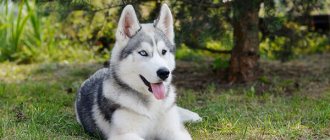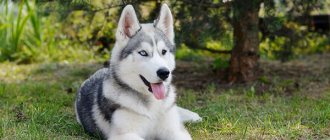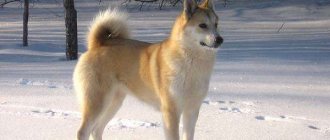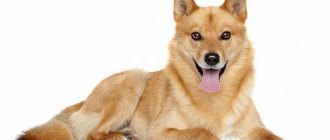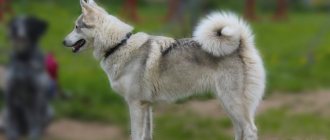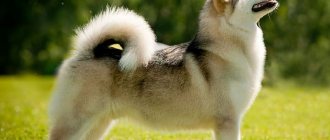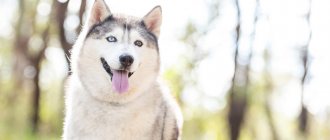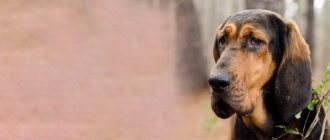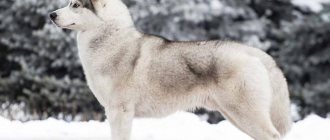The Yamthund is a hunting dog that loves freedom, space and an active lifestyle. They were used to catch fur-bearing animals, birds and even large predators. The breed is hardy, the animals are comfortable in any conditions. They are characterized by loyalty and devotion to their owner, bravely stand up for defense and get along with children. But this is not the kind of dog that can be kept on a leash all its life - guarding is not their only purpose. It is important for him to run, hunt, and be in the wild.
Origin of the breed
The Yamthund belongs to the Scandinavian huskies, which in ancient times were devoted companions to hunters. This is a type of Norwegian husky. Their related breed is the Norwegian Elghound, but the Yamthund is larger, larger and heavier. It was developed as an independent breed in 1946 in Sweden. The standard was published in 1953, official registration dates back to 1998.
Description of the breed
Yamthund is distinguished by a strong, muscular physique, movements are dexterous and confident. Laika is a large dog. Main characteristics of the breed:
| Appearance | Characteristics |
| Head | Slightly elongated, the area between the ears is wide. The skull is slightly rounded, the stop is well defined. |
| Front part | The muzzle from the stop to the nose is shorter than the skull, measured from the stop to the tubercle on the back of the head. It gradually tapers towards the tip of the nose. In a purebred animal, when viewed from the side, it should not be pointed. The nose is wide. The jaws are powerful, the teeth are white, and there is a scissor bite. The lips are pigmented and fit tightly to the teeth. Cheekbones are moderately expressed. |
| Ears | Erect, located high, pointed tips, movable. The height exceeds the width at the base. The inside of the ears is covered with fur. |
| Neck | Has clear outlines, long, flexible. |
| Paws | The forelimbs are strong, oval in shape, directed straight. The elbow joint is pressed to the chest, the shoulder blades are pulled back, long. Forearms are straight, with strong bones. The hindquarters are parallel when viewed from behind. The stifles and hocks are well angulated. |
| Tail | Set high, of medium thickness and length, curled into a loose ring, pressed to the rump and back. |
| Eyes | Oval in shape, dark brown in color. The look is calm, but always wary. |
| Frame | powerful, distinguished by clear outlines, longer than the height of the dog at the withers |
| Breast | It has curved ribs and good depth. |
| Wool | The cover is thick and straight, loosely fitting. The undercoat is fluffy, short, soft, and in purebred representatives it is cream-colored. The hair is short on the head, but longer on the chest, neck, hind legs and tail. |
Pros and cons of the breed
Swiss huskies are unpretentious animals. But it is not recommended to keep them in apartments - there is not enough space there to lead an active lifestyle. The advantages of the breed include the following:
- lack of aggression towards humans;
- energy;
- activity;
- high intelligence;
- endurance to work;
- loyalty to the owner;
- developed hunting instinct;
- no need to supplement with vitamins and minerals to improve immunity.
- proud disposition;
- difficulty in training;
- a tendency to certain genetic diseases.
Representatives of the breed are distinguished by a cold temperament - sometimes they refuse to make contact.
Peculiarities
The dog is distinguished by its courage, calm and affectionate disposition, loyalty, and energy. At the same time, he is a very stubborn and wayward dog. He is prone to dominance, but is in dire need of attention and love from all family members. Shows wariness towards strangers, but without aggression. If a dog grows up surrounded by cats and dogs, he has a neutral attitude towards them, but a hostile attitude towards strangers. The breed is characterized by excellent watchdog and security qualities, which are realized without additional training.
Breed standard
| FCI Standard No. 42 Standard publication date: 03/25/2003. Country of origin: Sweden. | FCI Classification Group 5. Spitz and primitive types of dogs. Section 2. Scandinavian hunting dogs. With operational tests (Sweden, Finland, Finland). |
Likes
Laika is a group of hunting dog breeds of ancient origin that developed in the European northern forest zone. Laikas are widespread in the taiga and are indispensable assistants for commercial hunters. Various breeds of huskies are bred and used for hunting in Finland, Sweden, Norway, Denmark, Canada and the northern regions of the USA. Laikas have a strong hunting instinct, which allows them to be used for different types of hunting and at different times of the year, which distinguishes them from some highly specialized breeds that have limited and seasonal use. With huskies they hunt squirrel, sable, marten, mink and other fur-bearing animals; for large predators - lynx, bear; ungulates - elk, deer, wild boar, roe deer, musk deer, etc.; upland and waterfowl.
Possessing a well-developed sense of smell, acute vision and hearing, the husky independently finds a hidden animal or bird and notifies the hunter by barking. When an animal or bird moves, it silently pursues them (watches), and when it stops again, it again gives a signal to the hunter. When shot, huskies scare ducks out of reeds or grass, lift pheasants out of thorny bushes, and bark those that have perched on a tree like a forest bird. The dog finds the wounded and killed bird and brings it to the hunter. When hunting ungulates, the husky silently follows the animal along the trail and, running in front, barking furiously, stops it and does not allow it to move, stopping it at every attempt with an angry bark and sharp, quick grabs.
A bear hunt occurs in a similar way: the husky finds a den and, with deft, quick grips, “holds” the jumping out animal. The dog uses a blood trail to find wounded animals. Initially, huskies were used only in the northern regions, but now, due to the spread of wild boars and other ungulates, they have become widely known and are successfully used in the Baltic states, the southern regions of the country, Kazakhstan, etc.
Laikas are affectionate to people, undemanding, and easily adapt to living conditions in large populated areas and apartments, without losing any of their hunting qualities.
A significant advantage of the husky is its undemanding nature when it comes to food. As a result of its very good digestion, the husky consumes almost half as much food as any other dog of the same weight. This remarkable quality was developed in taiga dogs under conditions of harsh existence and strict selection.
Laika can be considered one of the oldest dog breeds serving humans. Strelka and Belka, perhaps descendants of the very same husky that an unknown artist depicted on a fresco preserved in Kyiv back in 1037, with their flight into space provided convincing evidence of the outstanding properties of this group of northern dogs. To this day, they have retained characteristic features indicating their close relationship with the wolf and jackal. The method of application, as well as the environment, over many generations have fixed certain psychological and physiological characteristics in individual groups of huskies, on the basis of which huskies can be divided into three subgroups:
- Shepherd huskies
- Sled (polar) huskies
- Hunting huskies.
Shepherd huskies
The original breed is the Nenets Laika , related to the Laponian Laika, common in all northern regions of the Scandinavian Peninsula.
General characteristics: The Nenets Laika is a small, lightweight type, but still a compact dog. The height at the withers for males is no less than 45 cm, and for females no less than 40 cm. Their important protection in harsh climates is long hair. The wide skull extends into a moderately convex forehead. The transition from forehead to muzzle is well defined. The muzzle is shorter in relation to the skull, with dry cheekbones, tightly fitting the jaw and dry lips. The eyes are round, occasionally slanted, and dark hazel in color. Red-brown huskies have yellowish-green eyes. The practical use of this subgroup is obvious from the name. However, in addition to being excellent assistants for shepherds, they also perform well in hunting waterfowl, squirrels and even bears. It is interesting that when shepherding huskies are crossed with hunting huskies, the offspring experience an undesirable increase in hunting instincts, even bordering on feralism (unrestrained pursuit, bullying and devouring game, etc.). Crossbreeding also negatively affects the length of the coat, which is much shorter in crossbreeds, and thus does not fulfill its protective function (in swampy areas on thawed soil in the summer, huskies with insufficiently long hair are bothered by clouds of mosquitoes). A warning sign of unwanted crossbreeding in some generation is clearly enlarged occipital protuberances.
Sled (polar) huskies
They form the largest subgroup. They transport people and cargo wherever all roads suitable for vehicle traffic end in the north. In addition to working in a team (consisting of 8-13 dogs), huskies are also successfully used for driving elk or mountain bighorn sheep and deer. At a time when the polar bear was not yet protected by law, they justified themselves when hunting it. Due to the fact that these huskies are distributed over the vast territory of Siberia from the Ob to Chukotka, from the Arctic Ocean to the Amur and, therefore, are found in many variants, the following characteristics describe a typical husky of the eastern northern regions. General characteristics. The sled polar husky is a dog with strong, powerful bones and gives the impression of a strong, hardy dog. This is also reflected by its rather high height at the withers: in males it is no less than 60 cm, in females it is 58 cm. A highly developed chest is typical.
Hunting huskies
Hunting huskies are the main assistants of hunters in the vast forest areas of northern Europe and Asia. As hunters convincingly claim, a good hunting husky is the best weapon for them. In essence it is an all-round hunting dog. Back in the nineteenth century, outstanding Russian cynologists sought to include many species of these huskies into separate breed groups in order to consolidate their outstanding hunting abilities through further selection. In 1898, the first book about huskies by M. G. Dmirieva - Sulima was published in Russia, in which, based on the generalized experience of commercial hunters and the theory of specialists, huskies were highly appreciated. In 1920, V.I. Lenin signed the “Decree on Hunting,” which gave direction to the newly created cynology in the Soviet Union.
Standard huskies
Evidence of many years of intensive efforts is the presence of a wide breeding base of purebred Laikas. All modern types of huskies can be classified, according to the standard approved by a majority vote at the All-Union Cynological Meeting in 1947, as one of the four breeds below:
Russian-European Laika.
General appearance: The dog is of medium height, strong and dry type of constitution, with well-developed muscles, lively and agile. Height at withers. For males it is 52-58 cm, for females it is 2 cm less.
Head: Wedge-shaped, dry, rather wide in the skull, approximating an equilateral triangle. The length of the muzzle is slightly shorter than the length of the skull. The transition from the forehead to the muzzle is gradual, unnoticeable, the cheekbones are well defined. The muzzle is pointed, dry, parallel to the line of the forehead. Lips are dry and tight-fitting.
Eyes: With a cheerful, lively expression, clear. Medium size, oval, set somewhat obliquely, not sunken or protruding, brown and dark brown in any coat color.
Ears: Erect, mobile, small, set moderately high in the shape of a triangle, with a wide base and sharp tips.
Limbs: Straight and parallel. Pasterns slightly sloping, paws well-arched. Dewclaws on the hind legs are undesirable.
Tail: Set on high, curled or curled over the back or carried close to the hip. At high speed the ring unfolds. When the dog is calm, it is allowed to keep the tail down. In length (straightened) the last vertebra reaches the hock joint or is 1-2 cm shorter.
Coat: Dense, coarse, straight, with a soft undercoat. The outer hair on the neck, withers and shoulders forms a lush collar and scruff. The hair on the head, ears and limbs is short. On the hind legs on the back side the hair is longer and forms fluffy pants. The tail is pubescent evenly along its entire length, with slightly longer hair on its underside, which, however, does not form a dewlap.
Color: Black, white, red, piebald, zoned.
Faults: Elongated, massive muzzle in relation to the length of the skull, too small or large eyes, floppy, low-set ears with rounded tops, too long or saber-shaped tail, depigmentation of the nose. Poor undercoat development, wavy coat, too long hair on the inside of the tail and on the back of the front legs, short hair.
West Siberian Laika
General appearance: Dog of medium height, strong and dry type of constitution. Compared to the Russian-European Laika, it has a more extended format.
Height at withers: For males 54-60 cm, for females 2 cm less.
Head: When viewed from above, it appears as a sharp wedge with a wide crown. The length of the muzzle is approximately equal to the length of the skull. The occipital protuberance is well defined. The transition from forehead to muzzle is not sharp:
Muzzle: Wedge-shaped, the upper line of the muzzle is parallel to the line of the forehead, lips are dry, tightly fitting, without drooping or jowls.
Ears: In the shape of a slightly elongated triangle, erect, mobile, high set.
Eyes: Medium size, with a sharply slanted eyelid, brown in any coat color.
Body: The neck is muscular, dry, equal in length to the head. The chest is wide, deep and long, reaching down to the elbows and below. The withers are well developed and sharply defined. The back is straight, wide, muscular. The loin is slightly convex, short, wide, and muscular. The croup is moderately long and moderately sloping. The belly is moderately tucked.
Limbs: Straight and parallel. Elbows point straight back. Pasterns slightly sloping. The hind limbs are slightly wider apart than the forelimbs.
Tail: Curled in a ring or sickle over the back or carried close to the hip. At a fast pace, the tail unfolds, and can be lowered when the dog is calm. Tail length to the hock joint or 1-2 cm shorter.
Coat: Dense, coarse, straight, with a soft undercoat. On the neck, withers and shoulders, elongated hair forms sideburns, a collar and a scruff. The hair on the head, ears and the front sides of the legs is short. There are small featherings on the back of the hind legs. The tail is evenly lowered, between the toes the hair forms a small brush that covers the soles of the paws.
Color: White, black, zoned, red and brown of all shades, piebald, spotted. Speckling on the limbs to match the spots is acceptable.
Faults: Too long in relation to the skull, massive muzzle, lack of a pronounced or sharp transition from the forehead to the muzzle, round, small or large eyes, droopy, inactive, low-set ears with rounded tops. The tail is too long or saber-shaped. Depigmentation of the nose. Poor undercoat development, wavy coat.
Karelo-Finnish Laika
General appearance: Small in stature, strong, agile.
Height at withers: For males 42-48 cm, for females 2 cm less.
Head: Wedge-shaped when viewed from above. The parietal crest and occipital protuberance are weakly expressed, the transition from the forehead to the muzzle is faintly noticeable. The top line of the forehead and the line of the muzzle are parallel. Muzzle. Pointed. The lips are thin, dry, tight-fitting, and not saggy.
Ears: Small, erect, mobile, in the shape of a somewhat elongated triangle with sharp apexes.
Eyes: Small, oval, with moderately oblique eyelids. Dark brown.
Body: The chest is deep, flattened, the withers are well developed, the back is straight, muscular, the loin is short, convex, the croup is wide, short, almost horizontal, the belly is well tucked.
Limbs: Straight, parallel, hind legs set slightly wider than the forelimbs. The paws are round with tightly closed toes.
Tail: Set high, curled over the back or carried close to the hip, a sickle tail is acceptable. Evenly pubescent, reaching the hock joint or 1-2 cm shorter.
Coat: Hard, straight, dense, with a soft, lush undercoat. The hair on the head, ears and front legs is short. The hind legs have noticeable feathering. On the underside of the tail the hair is noticeably longer. On the neck and shoulders, longer hair forms sideburns and a fluffy collar.
Color: Red of all shades. White markings on the face, chest, belly, legs and tip of the tail are allowed, as is a dark mask. The nose is black; with a light red color, brown is allowed.
Faults: Too long, massive muzzle in relation to the skull, lack of a pronounced or sharp transition from the forehead to the muzzle, round, very large or very small eyes, floppy, low-set ears with a rounded top. The tail is too long. Dewclaws are not acceptable. Wavy coat and poor undercoat development.
East Siberian Laika
General appearance: Compared to the West Siberian Laika, this Laika has a more elongated format. In addition to greater length and height at the withers, East Siberian huskies also have more powerful bones.
Height at withers: For males 55-65 cm, for females 2 cm less.
Head: Wedge-shaped with a relatively wide skull and rounded occipital bone. The length of the muzzle approaches the length of the skull. The occipital protuberance is pronounced. The transition from forehead to muzzle is smooth, weakly expressed. The top line of the muzzle is parallel to the line of the forehead.
Ears: Erect, mobile, triangular in shape, with sharp or slightly rounded tips, not set very high.
Eyes: Small, with oval and moderately oblique eyelids, preferably dark brown or brown in any coat color.
Teeth: Large, white, scissor bite.
Body: The neck is muscular, approaching the length of the head. The withers are well developed, protruding sharply above the line of the back. The back is straight, wide, muscular.
Forelegs: Straight, parallel, with well-defined angles, elbows directed strictly back. Forearms straight, pasterns slightly sloping.
Hindquarters: Muscular, with long lower legs, parallel, with regular angulations. The metatarsus is set almost vertically. The paws are gathered into a ball. Dewclaws are allowed but not desirable.
Tail: Length reaching to the hock joint, or 1-2 cm shorter. As a rule, it is curled over the back or pressed against the thigh.
Movements: Fast, easy. The characteristic gait is an accelerated trot and a light gallop.
Nenets reindeer laika
The only people in the world who created a dog specifically for herding deer are the Nenets, whose entire way of life is based on reindeer herding. Among other peoples of the North, reindeer are herded by dogs selected from hunting or sled dogs.
The unique Nenets Laika exists in two forms: regular and short-legged. Short-legged animals cannot run quickly on loose spring snow, and in the past, and in some places even now, they are used during the calving period - they do not frighten or chase small deer, but at the same time they do not allow them to stray from the herd.
Like all northern herding dogs, Nenets huskies are covered with long, thick hair with a well-developed downy undercoat. This coat protects them not only from the cold, but also from midges. The length of the guard hair reaches 8 - 10 cm, the length of the guard hair on the neck, lower back, croup, hips is 13 - 15 cm, on the tail up to 20 - 25 cm. The short, beautifully lowered tail, thrown over the back, gives these dogs a special beauty. <
The exterior of purebred Nenets Laikas corresponds to the standard of domestic catalogs of the 50s. Constitution type - strong, dry. The type of behavior is balanced and active, but there are individuals with a clear choleric temperament. The height at the withers of males is not lower than 45 cm, of females - not lower than 40 cm. The height at the rump is equal to the height at the withers or 1 cm lower. The format index for males and females is approaching square. The head has a relatively wide skull, the forehead is convex, the transition from the forehead to the muzzle is sharp. The muzzle is short, with a sharply cut lower jaw so that it appears somewhat retracted. Lips are dry and tight-fitting. The ears are erect, small, with slightly rounded ends. The color is varied, zone-gray, black, white, red, piebald, spotted.
The movements of Nenets huskies are fast, graceful and light. The characteristic gait is an accelerated trot and gallop. Interestingly, when walking, dogs hardly bend their hind legs, just like the Chow Chow. Reindeer huskies have exceptional physical endurance and strength, surprising for their small size. Real happiness for them is jumping in deep, loose snow, which is difficult and tiring for other dogs. Alive, unusually important and distrustful, they are always on the alert, exploring everything, observing all living creatures around them, from a beetle to a person. Isolation is difficult to bear and they strive to constantly be in the company of people, dogs or other animals.
When breeding this breed, the Nenets strictly and ruthlessly culled individuals with a developed hunting instinct, which could attack newborn and young deer. Surprisingly, the orientation and research activity has not only been preserved, but has intensified and deepened, as far as one can judge by comparing the reindeer husky with other breeds from the Spitz group. It is the ability for long-term active study of the environment that has made it one of the best search dogs in the world -rescue service.
Reindeer herders highly value the help of these dogs, especially since young huskies quickly and easily learn the necessary skills from trained ones and distribute herding responsibilities among themselves. A valuable quality of this breed is its small size - deer shy away from large dogs, and the uniform, calm movement of the herd is constantly disrupted by sudden lunges of frightened animals. But crossbred dogs can have undesirable forms of behavior: aggressiveness towards people, a pronounced hunting instinct, insufficient mobility. Until recently, reindeer herders closely monitored the condition of the breed and did not allow crossbreeding with imported dogs, especially shepherds. Now, the huge number of stray dogs brought to the North and abandoned there to the mercy of fate makes selection difficult, and the breed is gradually dissolving, surviving only in remote corners of the tundra.
Small nurseries like the one existing in Chukotka in the village of Markovo can serve as centers for the conservation and development of the breed. The nursery arose there in 1962 on the site of a fur farm, whose buildings were adapted for keeping dogs. Then, in the late 50s and later, reindeer huskies began to be actively imported to the northeast of our country, to the reindeer herding collective farms of Kamchatka, Chukotka, and Yakutia. The dogs, whose homeland is the European North and Yamal, took root well and were loved by reindeer herders, there was a great demand for them, and they decided to create their own kennel in Chukotka, which, unfortunately, has now collapsed. The number of breeding dogs in 1988 was 18: 3 males and 15 females, among them several individuals of the short-legged form. Many of the bitches are over eight years old, and the best stud dog is thirteen.
In recent years, reproduction rates have been very low: 1984 - 48 puppies, 1985 - 43, 1986 - 45, 1987 - 45. Puppies begin to be sold to reindeer herding brigades when they are two months old. Why is there only three puppies per year for each bitch? There are several reasons, but the main one is the age of the manufacturers. The ability to keep replacement young animals is almost completely exhausted due to the negative consequences of inbreeding (inbreeding). A nursery with such a small population constantly needs new breeding material, preferably puppies. It is extremely difficult for adult huskies to find a place for themselves in an established flock, and they can simply be killed. Almost all reindeer huskies of Chukotka come from Markovo, and it is best to import new ones from the homeland of the breed - the European North and Yamal. Nenets huskies are highly flexible and adaptable. There are cases when they lived in large cities for more than ten years. The puppies, brought from Markovo to Moscow in the spring of 1988, survived the very hot summer well and did not lose their activity even at temperatures above + 30°C. Perhaps reindeer herding dogs can adapt to mountain sheep breeding areas and graze flocks there.
Samoyed husky
The Samoyed Laika (Samoyed Spitz), or “sam-mi” as it is called, is an amazingly beautiful dog, although with a rather independent character. These dogs love snow and do best in wide open spaces.
Advantages - Very beautiful - Loyal to the owner - Obedient - Smart
Difficulties - Somewhat independent - Sheds, leaves white fur everywhere
Dimensions: Male height - 51-56 cm, female -46-51 cm. Weight is proportional to height.
Walks: Needs long, vigorous walks and, if possible, she should be exercised at least once a week in a training area.
Grooming: Brush and comb regularly; If it gets wet, dry it with a towel. The undercoat sheds once a year; in these cases, try to comb out as much loose hair as possible. Washing helps with this; hair falls out more easily.
Feeding: One and a half to two and a half standard rations are recommended
From the history of the breed: The Samoyed Laika is a very beautiful dog of the Spitz type, which received its name from the word “Samoyed” - this is how the Nenets were previously called. In its homeland, it is a sled dog, which was also used as a guard dog and a reindeer dog. Fridtjof Nansen, going to the North Pole, took with him several Samoyed huskies. In Great Britain, a pair of dogs appeared in 1889; most Samoyeds there descend from this first pair.
General appearance: The Samoyed, as a primarily working dog, must be strong, agile and harmonious, and since it works in northern latitudes, its coat must be thick, dense and impermeable to snow and rain. A back that is too long is not good because a weak back makes the dog unfit for its main work; but an overly short body, like that of a chow-chow, is also a disadvantage for a sled dog. Breeders should strive for the golden mean - a slightly elongated, muscular body that allows freedom of movement, with a deep chest and rounded ribs, a strong, proudly arched neck, straight forelegs and an exceptionally strong broad loin. Both males and females at first glance give the impression of enormous capacity for work and endurance, but without coarseness in structure. An adult dog should be approximately 53 cm tall. Greater chest depth is usually associated with rather long limbs, which is why short-legged dogs are discarded. The croup and hind legs should be especially developed, the angles of the hock joints should be well defined; weakness of the hock joints or their closeness is considered a defect.
Color: Pure white; white with light fawn; cream. Head. Powerful, wedge-shaped, with a wide, flat forehead; the muzzle is of moderate length, tapering but not too sharp. Lips are black. The hair in front of the ears is short and smooth. A black nose is preferred, but brown or flesh-colored is acceptable. The jaws are strong.
Tail: Long and bushy, carried over the back when alert; when the dog is resting, sometimes it drops.
Feet: Long, slightly flat, slightly splayed. The soles are heavily protected by wool.
Husky
Husky is perhaps the most good-natured of all northern Spitz-like pointy-eared dogs. The history of her friendship with man, her exceptional devotion and reliability goes back centuries.
Advantages - Unpretentious - Friendly - Loves children - Smart - Reliable
Difficulties - Needs a lot of physical activity
Dimensions: Male height - 53-60 cm, females -5 1-56 cm. Male weight - 20.5-27 kg, females - 16-23 kg. Weight should be proportional to height.
Walking: A renowned luge racer with amazing endurance, strength and agility, this dog is not meant to be kept in the backyard.
Grooming: Daily brushing will keep the coat in good condition.
Feeding: One and a half to two and a half standard rations are recommended.
From the history of the breed: The ancestors of the husky - Siberian ship huskies - were bred by the nomadic Chukchi tribes in northeast Asia, who needed a hardy and strong sled dog, and not just a hunting assistant. During the Second World War, she performed admirably in the search and rescue service. Thanks to huskies, sled dog racing has become popular in a number of countries. Later, the husky was recognized as a show dog.
General appearance: Above average height, with a somewhat elongated body, hardy, strong dog; with light and free movements; with erect ears and thick fur, especially on the tail. Its purpose is to work in harness. Therefore, it is characterized by a smooth ride, combined with strength, agility and tirelessness. It should not be heavy and rough, nor light and fragile. Huskies have well-defined sexual dimorphism. However, the male should not be too massive, and the female should not be too light. Regardless of gender, these dogs are very hardy. In working condition, when the muscles are well developed, they have a relatively small weight. What is undesirable for a Husky is excessive bonyness or weightiness, tight or clumsy movements, straight or too loose shoulders, a weak, hunchbacked or sloping back, straightened hocks, weak soft pasterns, and splayed, flat paws.
Color: Any color, including white, and a variety of markings are acceptable. Huskies are characterized by lightened tan-like markings, forming a light mask and glasses of very diverse patterns, sometimes not found in other breeds.
Head: Medium size, in proportion to the body, neither coarse nor too fine. Slightly rounded at the top and gradually tapering from the widest part towards the eyes. The transition is pronounced, but not sharp; located midway between the tip of the nose and the occipital protuberance. The muzzle, with a straight bridge of the nose, should be of medium width and length, not narrow or raw, gradually tapering to a rounded nose. The nose of black, wolf-gray and fawn dogs is black, in copper-red dogs it is red-brown, and in pure white dogs it can be flesh-colored. In winter, pink stripes on the nose are allowed - “snow nose”.
Tail: Richly covered with hair, set just below the line of the back and carried above it with a beautifully curved sickle when the dog is alert. The raised tail should not be too curled, thrown to one side or spread across the back. When at rest it is lowered. The hair on the tail is usually of medium length, approximately the same, so that the tail is round in cross-section.
Nutrition
It is impossible to overfeed an animal; it is important to correctly select the components of its diet if the dog is kept at home. The natural menu of a healthy adult dog should include:
- bones;
- meat trimmings;
- offal;
- offal;
- sea fish without bones;
- raw vegetables, fruits;
- dairy products;
- cereals: buckwheat, millet, rice, oatmeal;
- bird.
It is forbidden to feed:
- spices;
- sweet;
- smoked meats;
- salty dishes.
We must not forget about free access to clean water - the dog drinks a lot. In winter, it compensates for the water with snow. If you choose dry food for your pet, it should be premium or holistic.
Health
The Yamthund breed is distinguished by good health, which must be maintained by a healthy lifestyle and proper nutrition. Dogs are resistant to weather changes and rarely catch colds. It is important to vaccinate the animal in a timely manner, as the dog can catch the infection from wild animals. It is recommended to frequently take the animal to see a veterinarian and monitor the condition of the urinary tract. There is an important nuance: you should not overfeed the dog: representatives of the breed are prone to gaining excess weight, lose the incentive to work, and problems appear. To prevent eczema, it is important to dry the coat and undercoat well after bathing.
Is it possible for people without experience to get West Siberian Laikas?
If you are a beginner, we strongly recommend that you abandon the idea of getting a West Siberian Laika first, even if you are offered one as a gift. Distinctive features of representatives of this breed are love of freedom and independence .
The owner should already know how to behave with them, and therefore should be familiar with the basics of keeping and training hunting and sled dogs. The difference between West Siberian huskies and service, decorative and herding breeds is very noticeable. This is manifested in their character, behavior and habits. And therefore, it is important that a person who wants to purchase a dog of this breed already has experience in keeping hunting or sled dogs. If you try to intuitively raise a working husky that was given as a gift, you will have to face great difficulties, and it is possible that this experiment will end in failure.
Moreover, it is necessary to take into account that not every person will be able to get along with the West Siberian Laika. It is not recommended to have them for people who are homebodies by nature, are accustomed to living in silence and do not accept hunting. West Siberian Laikas will not live up to the expectations of those people who want to raise a West Siberian Laika puppy into a faithful watchman. In addition, they will not be able to become good companions for humans.
It may happen that a novice hunter does not want to raise a West Siberian husky puppy and, to save time and avoid unnecessary difficulties, will try to immediately purchase an adult dog. This is a very serious mistake, since you need to remember that he is getting not just a friend, but a hunting assistant. It is also important to remember that likes are only associated with one person. Therefore, it is possible that they will treat the new owner coldly.
West Siberian Laikas feel best in the company of avid hunters or people who adhere to an active lifestyle and live in a private house. In this case, they will be able to maintain the high activity of the West Siberian Laika, which they so need.
Frequent illnesses and problems
Yamthund is a strong dog with good immunity and health. But even this breed is susceptible to diseases:
- hip dysplasia;
- arthritis;
- epilepsy;
- glaucoma;
- stones in the urinary tract;
- eczema;
- retinal atrophy;
- elbow dysplasia;
- cataract;
- ear and inner ear infections;
- diabetes.
Diabetes mellitus is a genetic disease that affects animals from 4 to 14 years of age, with the peak of the disease occurring at 7 to 9 years of age.
Dogs' body temperature is higher than human body temperature
The average body temperature in dogs ranges from 38.3 to 39.4 °C. Higher body temperatures attract fleas and ticks, which is why dogs are more likely to be bitten by them than humans. ⠀
The Saluki is the oldest known dog breed.
The Saluki is considered to be the oldest dog breed known to man. In Ancient Egypt they belonged to the royal families. They were treated with reverence during life, and were even mummified after death as pharaohs.
Collies were once considered a vicious breed
Collie was once considered a vicious breed of dog, mainly due to the fact that this breed is of Scottish origin, and the Scots were considered uneducated and poor people. Collies became a popular and prestigious breed in the 19th century when Queen Victoria became a fan.
How much does a West Siberian husky puppy cost?
If the owner is thinking about purchasing a West Siberian Laika, then he most likely makes a similar decision in order to use it for hunting.
Therefore, for him, the purity of the dog comes to the fore, which, in principle, buyers should take as a starting point when choosing dogs of other breeds. When choosing a candidate, the main attention is paid to the working qualities of the puppy’s parents or the dog itself, if we are talking about an adult husky. Many owners, when buying a hunting dog, pay attention to the exterior for the sole reason of understanding whether they are being offered a mixed breed. However, even experienced hunters cannot always establish a similar fact from small puppies.
Features of choice
In our country, there are quite a lot of West Siberian Laikas available from working parents. And most often they turn to private breeders for these animals. But buyers are not always able to determine the origin of the manufacturer. Even when they are shown a parent pair of huskies, it is possible that at least one of the animals among them will not be a representative of the declared breed. However, most people don't pay much attention to this. And, taking this into account, it becomes clear why such puppies are offered in such large quantities. Sellers set the price for them at 5 thousand rubles .
People who are familiar with the peculiarities of choosing dogs of this breed know that purebred influences both the external characteristics of the animals and their character traits and behavior. Therefore, to purchase a good assistant, it is recommended to contact nurseries. In them you can find vaccinated puppies with a pedigree. If desired, you can purchase puppies from parents with champion titles and numerous diplomas.
But since most people do not pay attention to purebred when choosing a hunting dog, the option of purchasing a puppy from private sellers seems more attractive to them due to its low cost. This is also facilitated by the fact that there are not many nurseries in our country, so it is not possible to satisfy the needs of all customers.
You should not expect that when you make an unexpected visit to the nursery, they will immediately be able to offer you a purebred West Siberian husky of high quality. First, you need to agree, and after that, most likely, you will have to wait a certain time . You must also have the required amount available, and this is usually quite a lot of money, because prices in Moscow for these puppies start from 10 thousand rubles. It is worth noting that even puppies that are similar in appearance can be offered at different prices. This situation arises due to the fact that they have a lot of differences. Therefore, you need to know that the price of the West Siberian Laika is affected by:
- purebred line;
- availability of awards from parents;
- fame of the nursery.
Cost of a West Siberian Laika puppy
Today in Russia you can find nurseries where they practice selling puppies without birth certificates. In other words, when applying for ZSL puppies in Moscow, you can purchase, or, for example, receive as a gift, a purebred dog without providing documents .
This option may suit those owners who do not plan to breed huskies in Moscow and prepare them for exhibitions of various levels. Typically, prices for such puppies in the Moscow region are noticeably lower and are in the range of 5-7 thousand rubles. If a buyer is interested in purchasing an adult West Siberian husky in the Moscow region, then the price will primarily depend on the size of the animal.
- For the so-called “squirrel chicks” you will have to pay about 5,000-7,000 rubles.
- Prices for “Sobolyatnits” in Moscow range from 7000-9000 rubles.
- If you want to buy a dog in Moscow that can hunt large animals, then its price will be 2.5 times more, unlike “squirrel dogs”, so you will have to pay at least 10,000 rubles for it.
